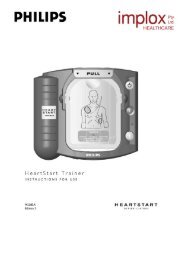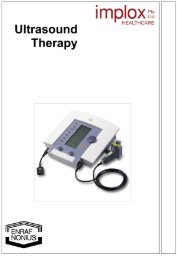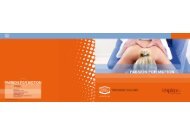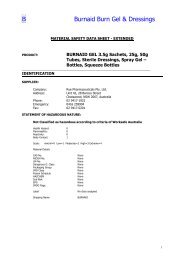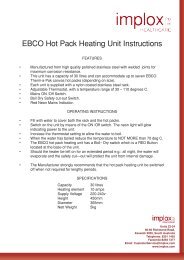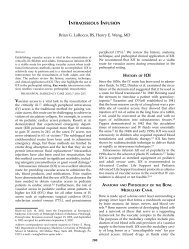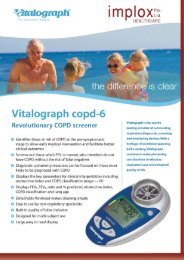Low and medium Frequency Electrotherapy - Implox
Low and medium Frequency Electrotherapy - Implox
Low and medium Frequency Electrotherapy - Implox
Create successful ePaper yourself
Turn your PDF publications into a flip-book with our unique Google optimized e-Paper software.
2.2.2 Endorphin release theory (Sjölund <strong>and</strong> Eriksson)<br />
This theory (27) is based on the assumption that, in chronic pain, there is either hypoactivity of the endorphin system,<br />
or an increased consumption of the endorphins released. The central nervous system can be stimulated to produce<br />
these endogenous opiates, resulting in pain suppression, by applying a ‘Burst-TENS’ current (also referred to as ‘lowfrequency,<br />
high-intensity TENS’ or ‘acupuncture-like TENS’). According to Sjölund <strong>and</strong> Eriksson, endorphins are only<br />
released at a burst frequency of 2-5 Hz, <strong>and</strong> 7 pulses per burst. The amplitude in Burst-TENS should be such that<br />
local muscle contractions occur, without discomfort (limit of tolerance).<br />
Pain reduction in conventional TENS (‘high-frequency, low-intensity TENS’) is ascribed to local, spinal release of<br />
endogenous opiates (encephalins) (27,32,34) .<br />
2.2.3 Postexcitation depression of the sympathetic nervous system (Sato <strong>and</strong> Schmidt)<br />
This theory (26) states that a postexcitation depression of the sympathetic nervous system can be obtained by<br />
stimulating the type II <strong>and</strong> type III nerve fibres. In this case, excessive stimulation of the type IV nerve fibres must be<br />
avoided. In conditions involving overactivity of the sympathetic nervous system the emphasis should therefore be on<br />
stimulating the type II <strong>and</strong> type III fibres.<br />
Trauma with<br />
nerve lesion<br />
Abnormal state of<br />
afferent neurons<br />
Sympathetic<br />
block<br />
Pain<br />
Distorted information<br />
processing in spinal cord<br />
Dysregulation of sympathetic<br />
activity (vasomotor, sudomotor)<br />
Trophic<br />
changes<br />
Fig. 2. Sympathetic reflex dystrophy.<br />
2.3 Selective stimulation<br />
From the foregoing it can be seen that there is a preference for stimulating the type II <strong>and</strong> type III nerve fibres. In<br />
addition, for muscle stimulation, selective stimulation of the type I (Aα) motor neurons is preferred.<br />
Investigators who have concerned themselves with selective stimulation of the peripheral nerves are Howson (8) ,<br />
Lullies (18,19) <strong>and</strong> Wyss (18,35) .<br />
8





